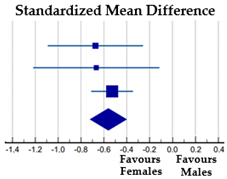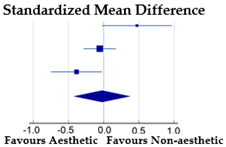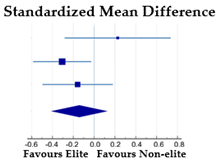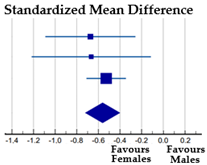You're using an outdated browser. Please upgrade to a modern browser for the best experience.
Please note this is an old version of this entry, which may differ significantly from the current revision.
Concerns about body image may affect athletes, mainly because of specific sports models to achieve successful performance.
- body dissatisfaction
- body image
- athletes
1. Introduction
Any form of physical activity can be beneficial to the physical and mental health of youth and adults when undertaken regularly and with sufficient duration and intensity [1,2]. These recommendations are highly relevant since there is simultaneously a worldwide prevalence of physical inactivity and obesity. Indeed, the current sedentary lifestyle is one of the main causes of overweight/obesity [3,4], and this results in a high prevalence of dissatisfaction with the perceived body image (BI) because of the ideal of body thinness prevalent in Western societies [5].
Sports make an important, though underused, contribution to the physical activity of persons of every age [1]. Athletes are engaged in structured and planned physical activity with prominent influences on their physical and mental health. Generally, a positive BI is associated with increased participation in physical activity and sports [6]. BI is considered a multidimensional construct focused on the appearance and function of the body [6]. Body dissatisfaction with an individual’s own physical appearance and body size, as well as discrepancies between actual and ideal dimensions, are cognitive, affective, and perceptual indicators of a negative BI [7]. In essence, a negative or positive BI is shown through the perceptual dimension (how I see myself), and cognitive and affective dimensions (how I think and feel about my physical appearance) [7].
In a sports context, a more favorable BI would depend on actual physical changes resulting from the sport practiced (e.g., body shape), perceived changes in the physique, and building self-efficacy and confidence. However, this relationship is by no means simple: while physical activity practice contributes to raising self-confidence through a number of discernible physical changes (e.g., an increase in fat-free-mass) resulting in improved BI satisfaction, BI may, in turn, induce motivation or dissuasion for physical activity and sports participation [6]. Thus, for example, exercise addiction arises from a misperception of BI [8] and can also result in decreased performance owing to overload and physical burnout [9].
An important aspect to consider is whether dissatisfaction is influenced by the type of exercise practiced. Some differences in body dissatisfaction recorded among practitioners of different sports [10] might depend on the importance of body weight and body thinness within that sport [11]. A particular relevance of physical appearance can be found in aesthetic sports, such as rhythmic gymnastics. In this case, the assessment of the athlete considers his/her morpho-kinetic abilities based on well-coded aesthetic requirements. Therefore, in addition to performance, the athlete’s physical appearance strongly contributes to the judgment, so much so that a prevalence of dissatisfaction among athletes involved in aesthetic sports has been reported in several studies [12,13]. With particular reference to the female gender, a higher risk of body concerns was observed in gymnastics than in swimming and long-distance running [14]. However, in these cases, it is important to distinguish the “sport” body image dissatisfaction (sport-BID = perceived discrepancy between current and ideal body size for sport) from the general body image dissatisfaction (BID) [15,16]. Indeed, the literature [15] shows that athletes, especially in aesthetic sports, would not be driven toward dieting and pathological weight control because of general BID, but because of the specific needs of the sport they play. Greenleaf [17] distinguished the BI of the athlete within an athletic context from a social BI that relates to the context of everyday life. Satisfaction/dissatisfaction with one’s body image will therefore depend not only on one’s physical appearance, but also on the social or sports environment of reference. Although athletes tend to be more satisfied than non-athletes in the social environment [18], in the sports environment, athletes often are under pressure from coaches and athletic trainers to achieve and retain a body that is favorable to their respective sport [19]. Regarding aesthetic sports, for example, it has been found that the ideal sports figure of the female gymnast does not coincide with the ideal figure in everyday life, being leaner [16].
According to previous literature reviews, athletes have a more positive BI than non-athletes both considering studies published between 1975 and 2000 [18] and between 2000 and 2012 [14]. Although both reviews made this comparison taking into account age and competitive level, no gender comparisons were made in either the first review (which reports a small percentage of males) or the second review (focused exclusively on females). The majority of studies in this field concern eating disorders, showing a higher incidence of disordered eating in athletes, particularly in aesthetic and weight-class-dependent sports [20]. De Bruin et al. [15] analyzed the role of BI in athletes’ disordered eating, showing that the athletic BI contributes greatly to this symptomatology. To date, research has focused primarily on the impact of negative BI on the athlete or pathological aspects without thoroughly considering the framework [21].
2. BID by Gender
Four studies (27%) included in the review analyzed athletes of both genders, but Krentz and Warschburger [41], Cardoso et al. [30], and Da Silva et al. [31] did not consider BID, so only the study (7%) of Francisco et al. [36] reported the necessary data to calculate the effect size. They reported the number, mean, and SD of male and female elite aesthetic athletes, non-elite aesthetic athletes, and non-aesthetic athletes (Table 1).
Table 1. BID by gender: results of the meta-analysis.
| Females | Males | % |  |
||||||
| Subgroup | N | Mean | SD | N | Mean | SD | Weight | SMD [95% CI] | |
| Elite aesthetic athletes [36] | 101 | −0.88 | 1.21 | 30 | −0.11 | 0.83 | 14.86 | −0.67 [−1.09, −0.26] | |
| Non-elite aesthetic athletes [36] | 99 | −0.51 | 1.19 | 15 | 0.27 | 0.96 | 8.51 | −0.67 [−1.22, −0.14] | |
| Non-aesthetic athletes [36] | 253 | −0.81 | 1.31 | 227 | −0.17 | 1.09 | 76.64 | −0.53 [−0.71, −0.35] | |
| Total (random effects) | 453 | 272 | 100.00 | −0.56 [−0.72, −0.40] | |||||
The meta-analysis on a total of 725 athletes revealed a medium and significant effect of gender on BID, with girls more dissatisfied than boys (SMD = −0.56, p < 0.001). The Cochran’s Q test and I2 statistics revealed no heterogeneity among the studies (χ2 = 0.558, DF = 2, p = 0.757; I2 = 0.0%).
3. BID by Type of Sports: Aesthetic Sports vs. Non-Aesthetic Sports
Only three studies (20%) on female athletes (two on adolescents [28,36] and one on young adults [40]) reported the necessary data to perform a meta-analysis on the effect of sport type on BID based on a total of 582 female subjects: 201 girls engaged in aesthetic sports (at elite level) and 381 girls engaged in non-aesthetic sports (Table 2).
Table 2. BID by type of sports in female athletes.
| Aesthetic Sports | Non-Aesthetic Sports | % |  |
||||||
| Study | N | Mean | SD | N | Mean | SD | Weight | SMD [95% CI] | |
| Borrione et al. [28] | 20 | −0.5 | 0.8 | 80 | −1.0 | 1.1 | 26.91 | 0.47 [−0.02, 0.97] | |
| Francisco et al. [36] | 101 | −0.88 | 1.21 | 253 | −0.81 | 1.31 | 39.76 | −0.05 [−0.29, 0.18] | |
| Kong and Harris [40] | 80 | −1.34 | 1.09 | 48 | −0.94 | 0.93 | 33.33 | −0.39 [−0.75, −0.23] | |
| Total (random effects) | 201 | 381 | 100.00 | −0.02 [−0.42, 0.37] | |||||
Meta-analysis revealed a non-significant effect of the type of sports on BID in female athletes (SMD = −0.02; p = 0.899). The Cochran’s Q test and I2 statistics revealed a significant heterogeneity among the studies considered (χ2 = 7.68, DF = 2, p = 0.02; I2 = 73.96%).
4. BID by the Level of Sport: Elite Level vs. Non-Elite Level in Aesthetic Sports
The same studies examined in the above analysis were used to perform a meta-analysis on the effect of the level of aesthetic sports on BID (Table 3) based on 420 female subjects.
Table 3. BID by the level of sports in female athletes.
| Elite Level | Non-Elite Level | % |  |
||||||
| Study | N | Mean | SD | N | Mean | SD | Weight | SMD [95% CI] | |
| Borrione et al. [28] | 20 | −0.5 | 0.8 | 61 | −0.7 | 0.9 | 20.93 | 0.23 [−0.28, 0.74] | |
| Francisco et al. [36] | 101 | −0.88 | 1.21 | 99 | −0.51 | 1.19 | 43.39 | −0.31 [−0.59, −0.03] | |
| Kong and Harris. [40] | 80 | −1.34 | 1.09 | 59 | −1.15 | 1.32 | 35.68 | −0.16 [−0.50, 0.18] | |
| Total (random effects) | 201 | 219 | 100.00 | −0.14 [−0.41, 0.12] | |||||
The meta-analysis revealed a small and non-significant effect of the elite level in aesthetic sports on BID compared to the non-elite level (SMD = −0.14; p = 0.293). The Cochran’s Q test (χ2 = 3.334, DF = 2, p = 0.189) and I2 statistics (40.01%) revealed a moderate and non-significant heterogeneity among the studies considered.
5. BID by Weight Status: Underweight Athletes vs. Normal-Weight Athletes
Taking into account the mean BMI values, only the study of Borrione et al. [28] considered underweight and normal-weight athletes: the international- and national-level rhythmic gymnasts’ mean BMI value fell in the underweight category, while the controls’ (athletes practicing basketball, volleyball, Taekwondo) mean BMI values fell into the normal-weight category. The meta-analysis revealed a small (SMD = 0.35), but significant (p = 0.014) effect of the weight status on BID, with underweight athletes less dissatisfied than those of normal weight, despite the fact that the former practiced an aesthetic sport and the latter sports non-focused on leanness. The Cochran’s Q test (χ2 = 0.355, DF = 1, p = 0.551) and I2 statistics (0%) revealed no heterogeneity among the samples considered (Table 4).
Table 4. BID by weight status in female athletes.
| Underweight | Normal-Weight |  |
|||||||
| Subgroup | N | Mean | SD | N | Mean | SD | Weight | SMD [95% CI] | |
| UW (international RG) vs. NW (controls) [28] | 20 | −0.5 | 0.8 | 80 | −1.0 | 1.1 | 31.55 | 0.47 [−0.02, 0.97] | |
| UW (national RG) vs NW (controls) [28] | 61 | −0.8 | 0.9 | 80 | −1.0 | 1.1 | 68.45 | 0.29 [−0.04, 0.63] | |
| Total (random effects) | 81 | 160 | 100.00 | 0.35 [0.07, 0.63] | |||||
6. Sport-BID by Gender
Four studies (27%) provided information about the influence of gender on sport-BID; a meta-analysis was performed based on a total of 501 participants (413 females and 88 males), all engaged in aesthetic sports at an elite level. Voelker et al. [48] reported data for female figure skaters and Voelker et al. [49] reported data for male figure skaters. The meta-analysis revealed a moderate and significant effect of gender on sport-BID: female athletes are more dissatisfied about their actual body size concerning their ideal sport-practiced body size compared to the males (SMD = −0.74; p < 0.001). The Cochran’s Q test (χ2 = 3.935, DF = 3, p = 0.269) and I2 statistics (23.76%) revealed no heterogeneity among the studies considered (Table 5).
Table 5. Effect of gender on Sport-BID in elite aesthetic athletes.
| Females | Males |  |
|||||||
| Subgroup | N | Mean | SD | N | Mean | SD | Weight% | SMD [95% CI] | |
| Elite dancers [23] | 53 | −1.45 | 1.32 | 13 | 0.08 | 0.95 | 17.05 | −1.20 [−1.85, −0.56] | |
| Elite gymnasts [23] | 50 | −1.20 | 1.04 | 19 | −0.58 | 1.02 | 22.66 | −0.59 [−1.13, −0.05] | |
| Elite figure skaters [48,49] | 272 | −1.00 | 1.48 | 29 | −0.26 | 0.77 | 36.18 | −0.52 [−0.90, −0.13] | |
| Elite aesthetic sports [41] | 38 | −0.80 | 1.00 | 27 | 0.00 | 0.70 | 24.10 | −0.89 [−1.41, −0.37] | |
| Total (random effects) | 413 | 88 | 100.00 | −0.74 [−1.03, −0.46] | |||||
This entry is adapted from the peer-reviewed paper 10.3390/ijerph20065228
